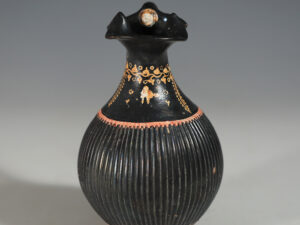An oenochoe, also spelled oinochoe, which means wine-pourer, is a wine jug and a key form of ancient Greek pottery. There are many different forms of oinochoe; Sir John Beazley distinguished ten types. The earliest is the olpe (ὀλπή, olpḗ), with no distinct shoulder and usually a handle rising above the lip. Key characteristics are the trefoil mouth, curved body and single handle.
The lustrous black gloss of this vessel indicates that it is from the Apulian region of southern Italy. From the 8th century BC onwards, southern Italy was populated by a vast number of Greek colonies, so much so that the Romans referred to the area as Magna Graecia – ‘Great Greece’. These Greek colonies were instrumental in bringing Greek culture to Italy, greatly influencing Roman literature, philosophy, and material culture in turn. Items from Apulia are characterised by the glossy black glaze covering the dish and by polychromatic pigments of white, ochre, and maroon. Pieces as this fine example are attributed to the Xenon group, a variety of Apulian pottery identifiable by their shape, such as the karanthos, and the decorative motifs rendered in a matte pinkish colour.
To discover more about Ancient Greek pottery, please visit our relevant blog post: Collecting Ancient Greek Vases.






















